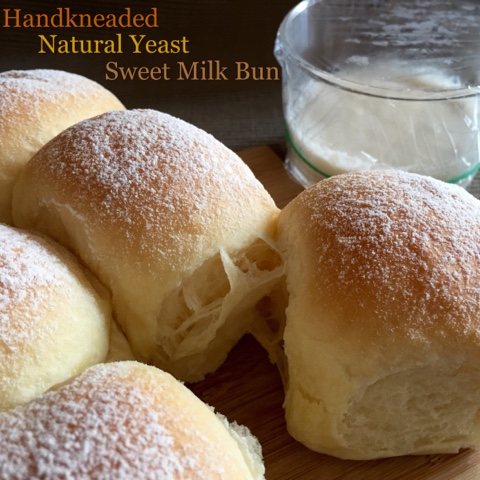Handkneading bread dough is an strenuous job. Profuse perspiration is inevitable. That's the reason for hanging a long hand towel over the neck is a must. With a slightly more cooling weather today, I decided to give my bread maker a well deserved rest, and let my hands and arms did a good workout.
By substituting part of the commercial yeast by natural yeast, the proofing time had to be extended slightly. The bread was slightly more chewy, besides it usual softness :P
Yield : 9 buns in 18cm square pan
Bread weight: 437g
Raw dough weight: 455g
Natural Yeast (100% hydration)
Day Temperature: 30 degree Celsius
Ingredients
80g natural yeast
5g cool boiled water
5g unbleached bread flour
1g raw sugar
Click the link for the method of cultivating natural yeast:
Directions
1. Take out the natural yeast, which you have continuously fed for at least 3 days, from the fridge and let it returns to room temperature.
The natural yeast has to be active and able to double in volume within an hour after feeding.
2. Feed the natural yeast with 5g each of water and bread flour, as well as 1g of raw sugar. The sugar will help to invigorate the yeast faster.
3. Cover the bottle and wait for the natural yeast to double in volume. Mark the initial height of the natural yeast with a rubber band.
Just after feeding,
5. Collect 50g of natural yeast for later bread baking use, and keep the remaining back to the fridge.
Bread dough
Ingredients
105g whole milk 全脂牛奶
20g condensed milk 炼乳
35g fine sugar 细糖
20g beaten egg 蛋液
1/4 tsp salt 盐
105g whole milk 全脂牛奶
20g condensed milk 炼乳
35g fine sugar 细糖
20g beaten egg 蛋液
1/4 tsp salt 盐
30g softened unsalted butter 室温无盐奶油
190g bread flour 高筋面粉
20g top/cake flour 低筋面粉
50g natural yeast 天然酵母面种
1/2 tsp instant dry yeast 即发干酵母
Some flour for sprinkling on bread top
些许面粉撒做表面装饰
Direction
1. While waiting for the natural yeast to double in volume, let the cold fresh milk and condensed milk stand in room temperature for about 25 minutes to thaw.
2. When the milk mixture temperature has reached almost room temperature, sprinkle commercial dry yeast over the surface without stirring it. Cover with a lid and let it stands for about 15 minutes to activate the yeast.
3. Pour all the dry ingredients and natural yeast into a mixing bowl, except the butter. Mix well.
4. Pour in the yeast-milk mixture from (2), and beaten egg. Stir in one direction to mix the ingredients into a lump which pulls away from the wall.
5. Cover the dough with a lid and let the dough rest for 15 to 20 minutes. This allows the flour to absorb the liquid which would make kneading easier later.
6. Wear a pair of CPE gloves to handle the bread dough. Start kneading the dough by slamming, pulling and folding, for about 10 minutes, or till the dough become smooth and elastic.
The stickiness would reduce after about 1 to 2 minutes into kneading.
Slam and pull;
7. Spread out the dough and apply softened butter to the dough.
8. After incorporating the butter to the dough, grab one end of the dough and slam it against the work top. Fold in, grab the adjacent end and repeat the process. Knead well for another 10 to 15 minutes till the dough can be stretched into a membrane.
9. Pull down the side of the dough and tuck in at the bottom. Store the dough in a clean mixing bowl lightly greased. Spray some water and cover with a lid. Allow the dough to proof for about 60 to 75 minutes, or till it doubles in size.
75 minutes later
11. After the dough has double in size, sprinkle some flour over, and transfer it to the work top. Press down to release the trapped air.
12. Divide the dough into 9 equal portions, about 50g each.
13. Roll up the individual doughs and shape into balls by pulling down the side of the dough, and seal at the bottom.
14. Coat the dough ball with some flour and roll it within your hand into a round ball. Place into the lined baking tin.
15. Spray some water and let the dough proof in a closed oven for about 45 minutes, or when the dough almost reaching the rim.
16. Remove the dough from the oven. Start to preheat the oven to 180 degree Celsius.
17. Use a sieve to sprinkle some flour over the top of the dough.
18. When the dough is in the oven, lower the temperature to 160 degree and bake for 10 minutes; further reduce the temperature to 150 degree Celsius and bake for 10 to 12 minutes, or till the top slightly brown.
Lower oven temperature from 180 to 160 degree Celsius and bake for 10 minutes.
Reduce the oven temperature from 160 to 150 degree and bake for 10 to 12 minutes.
End of baking Y(^_^)Y19. Transfer the bread out of the oven and lift out from the tin onto a cooling rack Immediately.
20. Enjoy when the temperature cools down :P













































Hi Ngai Leng, can I use instant dry yeast only? If yes, may I know the amount to use? Many thanks.
ReplyDeleteCaroline Gee
Hi Ngai Leng, can I use instant dry yeast only? If yes, may I know the amount to use? Many thanks.
ReplyDeleteCaroline Gee
Hi Caroline,
DeleteThis is the link to the similar recipe using commercial yeast:
http://mymindpatch.blogspot.com/2014/11/sweet-milk-buns.html
Thank you Ngai Leng. I love all your bread recipes!
DeleteThank you Ngai Leng. I love all your bread recipes!
DeleteGlad to share with you. Happy to receive your support :)
Delete